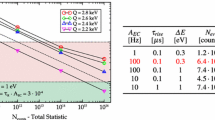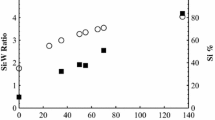Abstract
A microwave kinetic inductance detector (MKID) is a superconducting pair breaking detector that offers a number of unique advantages for realizing large-format arrays of ultra-sensitive detectors, such as inherent multiplexibility and relative ease of fabrication. With the detection threshold being set by the Cooper pair binding energy, and correspondingly, the superconducting critical temperature (\(T_\mathrm{c}\)), typically well-understood MKID materials such as aluminum (Al) present a lower limit on the operating frequency. Aluminum manganese (Al-Mn) is a promising candidate material for MKIDs because it can be fabricated with nearly identical processing as pure Al, but allows for control of the \(T_\mathrm{c}\) with varying levels of Mn doping or post-deposition heat treatment. We present initial results from an early characterization of AlMn using a series of lumped-element superconducting microwave resonators, including measurements of \(T_\mathrm{c}\), internal quality factor, and noise performance over a range of Mn doping.




Similar content being viewed by others
References
P.K. Day, H.G. LeDuc, B.A. Mazin, A. Vayonakis, J. Zmuidzinas, A broadband superconducting detector suitable for use in large arrays. Nature 425, 817–821 (2003)
S.W. Deiker, W. Doriese, G.C. Hilton, K.D. Irwin, W.H. Rippard, J.N. Ullom, L.R. Vale, Superconducting transition edge sensor using dilute almn alloys. Appl. Phys. Lett. 85(11), 2137 (2004)
Y. Lv, H. Huang, T. You, F. Ren, X. Ou, B. Gao, Z. Wang, Realization of precise tuning the superconducting properties of mn-doped al films for transition edge sensors. J. Low Temp. Phys. 202, 71–82 (2021)
S.T. Ruggiero, A. Williams, W.H. Rippard, A. Clark, S.W. Deiker, L.R. Vale, J.N. Ullom, Dilute al-mn alloys for low-temperature device applications. J. Low Temp. Phys. 134(314), 973–984 (2004)
D.R. Schmidt, H.M. Cho, J. Hubmayar et al., Al-mn transition edge sensors for cosmic microwave background polarimeters. IEEE Trans. Appl. Supercond. 21, 196–198 (2011)
E.M. Vavagiakis, N.F. Cothard, J.R. Stevens, C.L. Chang, M.D. Niemack, G. Wang, V.G. Yefremenko, J. Zhang, Developing almn films for argonne tes fabrication. J. Low Temp. Phys. 199, 408–415 (2019)
G. Jones, B.R. Johnson, M.H. Abitbol et al., High quality factor manganese-doped aluminum lumped-element kinetic inductance detectors sensitive to frequencies below 100 ghz. Appl. Phys. Lett. 110, 222601 (2017)
G.C. Neil, D.R. Schmidt, N.A. Tomlin, J.N. Ullom, Quasiparticle density of states measurements in clean superconducting almn alloys. J. Appl. Phys. 107, 093903 (2010)
Gallinaro, C. Rizzuto, Effect of transition metal impurities on the critical temperature of superconducting al, zn, in, and sn. Phys. Rev. B 148, 353–361 (1966)
F.T. Hedgcock, P.L. Li, Magnetic susceptibility of dilute al-mn alloys. Phys. Rev. B 2(5), 1342 (1970)
D. Li, J.E. Austermann, J.A. Beall, D.T. Becker, S.M. Duff, P.A. Gallardo, S.W. Henderson, G.C. Hilton, S.-P. Ho, J. Hubmayr et al., Almn transition edge sensors for advanced actpol. J. Low Temp. Phys. 184(1), 66–73 (2016)
A.J. Anderson et al., Performance of Al-Mn transition-edge sensor bolometers in SPT-3G. J. Low Temp. Phys. 199, 320–329 (2020)
Acknowledgements
Work at Argonne, including the use of the Center for Nanoscale Materials, an Office of Science user facility, was supported by the US Department of Energy, Office of Science, Office of Basic Energy Sciences and Office of High Energy Physics, under Contract No. DE-AC02-06CH11357. Zhaodi Pan is supported by ANL under award LDRD-2021-0186.
Author information
Authors and Affiliations
Corresponding author
Ethics declarations
Conflict of interest
The authors declare no competing interests.
Additional information
Publisher's Note
Springer Nature remains neutral with regard to jurisdictional claims in published maps and institutional affiliations.
Rights and permissions
About this article
Cite this article
Lisovenko, M., Pan, Z., Barry, P.S. et al. Characterization of the Superconducting Microwave Properties of Aluminum Manganese. J Low Temp Phys 209, 1158–1164 (2022). https://doi.org/10.1007/s10909-022-02845-2
Received:
Accepted:
Published:
Issue Date:
DOI: https://doi.org/10.1007/s10909-022-02845-2




